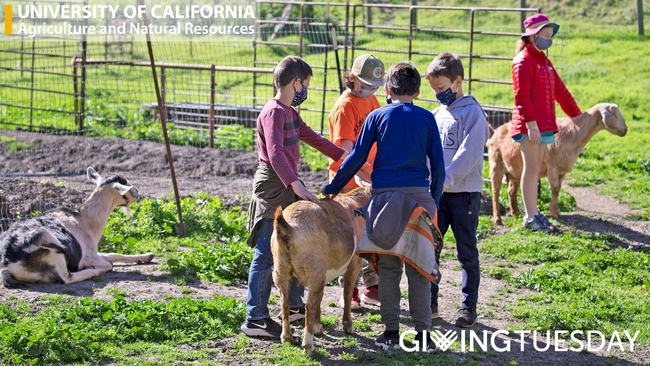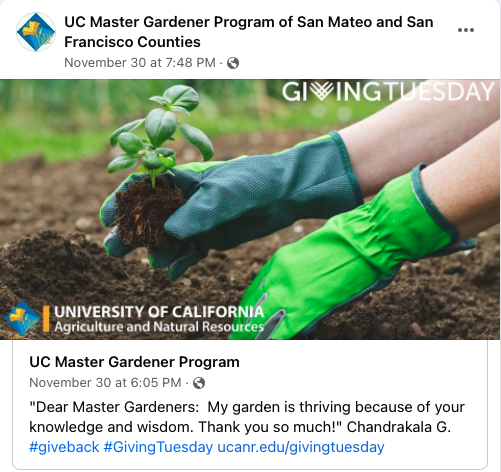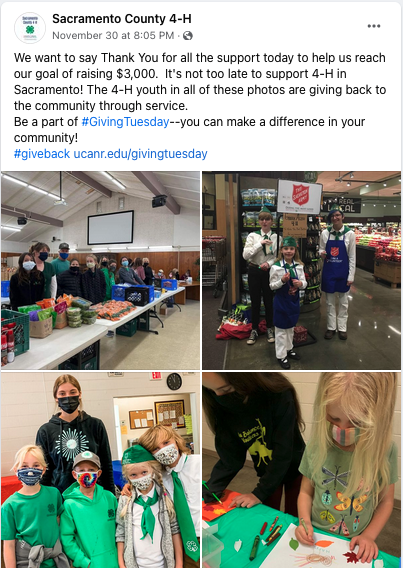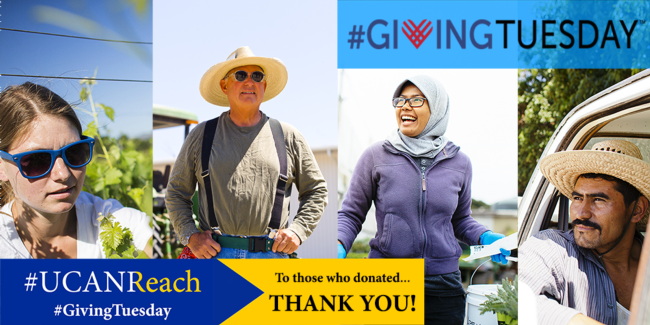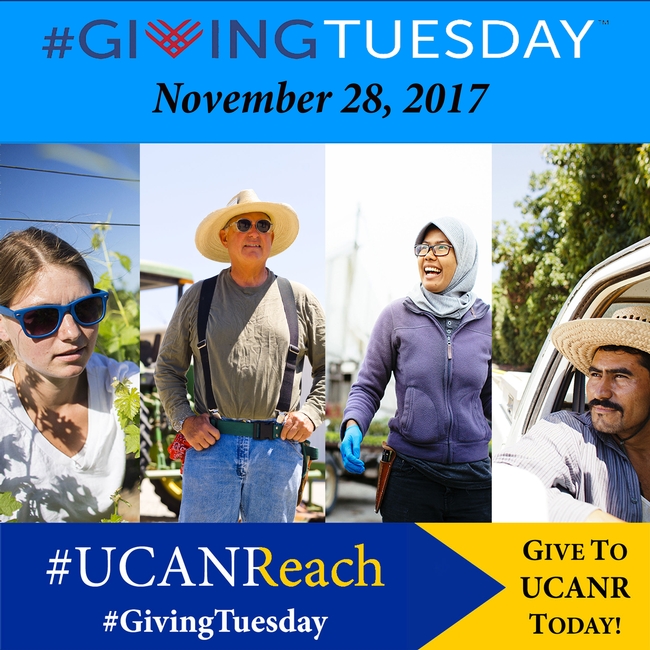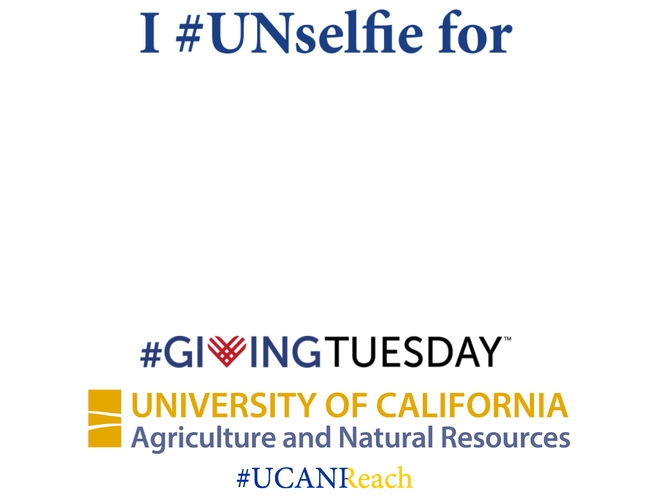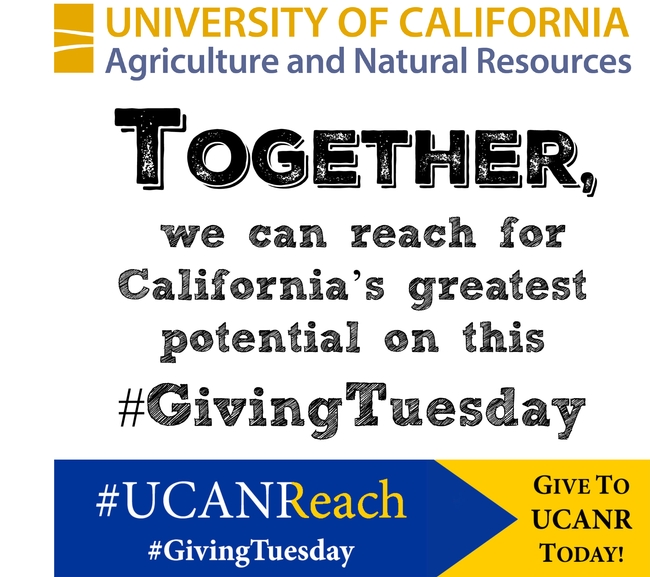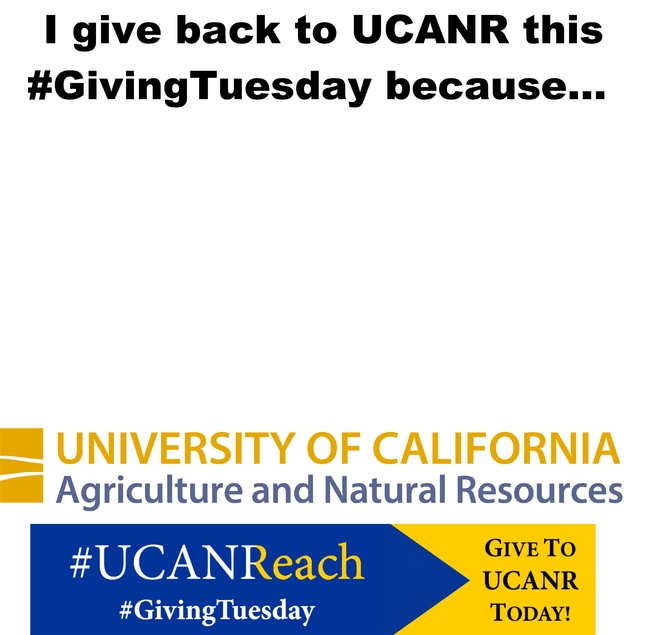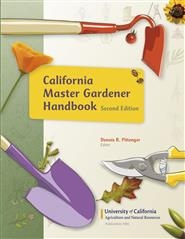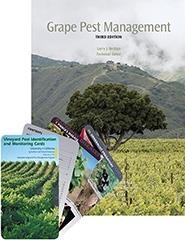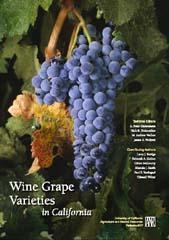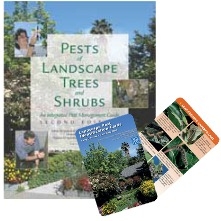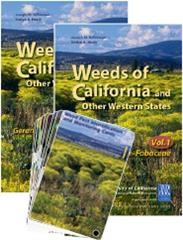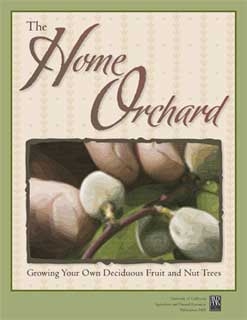Posts Tagged: gifts
Donors show strong support for UC ANR in 2021
Nearly $125,000 was donated for UC Cooperative Extension and the statewide programs, institutes and research centers that make up UC Agriculture and Natural Resources on GivingTuesday 2021, a globally recognized day of generosity,
“Our giving days are a small, but very important piece of UC ANR's annual fundraising,” said Greg Gibbs, executive director of Development Services. “In the last three months alone, we received two of the largest single gift pledges in our history – totaling $4.8 million to support research and extension.”
For GivingTuesday, on Nov. 30 this year, $40,000 was offered to incentivize giving to UC ANR projects and programs. This included $20,000 in matching funds provided by the California 4-H Foundation and donations from 4-H Foundation Board members designated for the 4-H program. It also included $20,000 awarded for programs that met challenges such as attracting the greatest number of unique donors on GivingTuesday. The prizes were drawn from funds raised throughout the year for UC ANR's Incentive Fund, which is used to encourage giving to all ANR programs.
Some donors left messages about why they support the programs, which collectively reach every county in California:
- “It's not always about what you have or get...it's more about what you give.” – Orange County
- “UCCE brings so much news we can use to the county. Thank you for all you do!” – Glenn County
- “4-H really helped me be a responsible person growing up. I am paying it forward. Thank you to all the adults who donate their time year after year.” – Sonoma County
- “Thank you for all your educational efforts to increase agricultural and native plant literacy!” – Ventura County
- “The 4-H Program helped our daughters develop their communication, leadership, citizenship, new skills and make lifetime friendships with others with the same passion. Our granddaughter enjoys it, too!” – Fresno County
- “UC ANR Elkus Ranch has been a foundational resource for my growing child and many children in the area. Thank you for this important work!” – Bay Area
- “Your work supports our business – flower farming in a way that works with nature. Thank you!” – UC Integrated Pest Management Program supporter
- “Thanks for keeping food safe and safely preserved.” – UC Master Food Preserver supporter
Examples of specific 4-H youth development projects made possible by the GivingTuesday donations include robotics in Placer County and leadership development, sheep and goat projects in Alameda County.
The UC Master Gardener Program will use the funds to develop a demonstration garden in San Luis Obispo County, the Sherwood Demonstration Garden in the Central Sierra, a sensory and pollinator garden in Stanislaus County and gardening projects in other parts of the state.
“These donations reflect donors' appreciation for UC ANR's work in their communities and we are so grateful for their support,” said Glenda Humiston, University of California vice president for agriculture and natural resources.
GivingTuesday is only one of many fundraising activities UC ANR conducts throughout the year.
To learn about other ways to contribute, visit https://donate.ucanr.edu.
UC ANR supporters give over $85,000 on #GivingTuesday
Thanks to everyone who participated, UC ANR's #GivingTuesday campaign was a tremendous success.
“We surpassed our goal of $60,000, raising $85,168,” said Mary Maffly Ciricillo, director of Annual Giving and Individual Gifts. “This is close to a 24 percent increase over last year's Giving Tuesday total of $68,322.”
As an added incentive to potential donors, ANR received over $37,000 in donations toward match challenge funds supporting all of UC ANR programs.
The California 4-H Foundation alone brought in over $32,000. Compared to 2016, there was a 250 percent increase in giving to UC ANR programs – including Master Gardeners, Master Food Preservers, IPM, the REC System, and county offices – totaling over $15,000.
The number of gifts received also rose, from 224 gifts in 2016 to 318 gifts this year. “We even received a gift designated to urban horticulture!” Ciricillo said.
In addition to raising money, the #GivingTuesday social media campaign helped raise the visibility of ANR programs and awareness that programs such as the 4-H Youth Development Program are part of the University of California.
The UC Master Gardener Program team made a video of the unselfies posted on social media by their supporters: https://www.youtube.com/watch?v=xI_tVcNhBcQ.
“We appreciate everyone's cooperation in this fundraising effort and hope we can continue to build on our success for the next #GivingTuesday,” Ciricillo said. “These private funds will help us expand UC ANR's reach.”
Below is a list of funds that donors selected to receive their Giving Tuesday gifts:
- 4-H Foundation UC Donor Funds
- 4-H Undesignated
- Alameda County Master Gardener Fund (Endow)
- Alameda County UCCE - Master Gardeners
- ANR - California Naturalist Scholarship Fund
- ANR - Giving Tuesday Match Fund
- ANR - Master Food Preservers Fund
- ANR - Master Gardener Annual Giving Fund
- ANR Informatics and GIS Fund
- California Institute for Water Resources
- Central Sierra - UCCE
- Colusa County UCCE - Master Gardener Program
- Contra Costa County UCCE Fund
- Desert Research and Extension Center FARM SMART Fund
- El Dorado County UCCE - Master Gardeners
- El Dorado County UCCE - Rangeland Fund
- Elkus Ranch Fund
- Fresno County UCCE
- Hopland REC Fund
- Integrated Pest Management Program Fund
- Kern County - 4-H Program
- Kearney Research and Extension Center Fund
- Los Angeles County UCCE - Master Gardeners
- Los Angeles County UCCE Fund
- Lindcove Research and Extension Center
- Marin Master Gardeners Opportunity Fund
- Merced County Agriculture Extension and Research Endowment
- Merced County UCCE - Master Gardener Fund
- Nutrition Policy Institute General Fund
- Orange County UCCE - Master Food Preserver Fund
- Orange County UCCE Fund
- Plumas County UCCE - Project Learning Tree
- Research and Extension Center System
- Riverside County UCCE - Master Gardeners
- Sacramento County UCCE - Master Gardener Fund
- San Joaquin County UCCE - Master Gardener Fund
- San Mateo County - 4-H Program
- San Mateo County UCCE - Master Gardener Greenhouse
- San Mateo County UCCE Fund
- San Mateo/San Francisco UCCE - Master Gardener Fund
- San Mateo/SF UCCE - Master Food Preserver
- Santa Barbara County 4-H
- Sierra Foothill Research and Extension Center Fund
- Sonoma County UCCE - Citizen Science Projects
- Statewide Master Gardener Endowment Fund
- Statewide Program - Nutrition, Family and Consumer Sciences Program
- Sutter-Yuba Counties UCCE - Master Gardeners
- UC California Naturalist Program
- UCCE Master Gardeners of Orange County
- Urban Horticulture
- Ventura County Master Gardeners
- Ventura County UCCE - Master Gardener Fund
- Ventura County UCCE Fund
UC ANR encourages posting unselfies for #GivingTuesday Nov. 28
On Nov. 28, UC Division of Agriculture and Natural Resources will participate in #GivingTuesday, a global day of giving powered by our social networks. Celebrated on the Tuesday after Thanksgiving, #GivingTuesday kicks off the charitable season.
Although not as well-known as the shopping events Black Friday and Cyber Monday, #GivingTuesday appeals to people who are swept up in the spirit of giving at the end of the year. Participants post “unselfies” on social media, as opposed to selfies, stating why they donate. By posting these photos on social media about why they give on #GivingTuesday, donors and volunteers celebrate and encourage giving.
Anyone can post an “unselfie.” Simply visit ucanr.edu/givingtuesday, download and print an unselfie sign that says, “I #UNselfie for ____ #GivingTuesday,” “Together, we can reach for California's greatest potential on this #GivingTuesday” and “I'm donating to UCANR this #GivingTuesday because…” Participants can hold the sign below their face and snap an unselfie to post on Instagram, Facebook, Twitter, Snapchat and other social media with the hashtags #GivingTuesday and #UCANReach.
For UC ANR, #GivingTuesday is an opportunity to raise funds for UC Cooperative Extension county programs, research and extension centers and statewide programs. As a result of the ongoing effects of the drought, recent wildfires and persistent pockets of poverty, California's needs in the coming year will be great, and year-end giving presents an opportunity for donors to assist.
“UC Cooperative Extension professionals have a deep passion for their work and a dedication to the communities they serve,” said Glenda Humiston. University of California vice president for agriculture and natural resources. “While most deliver their research and programs quietly every day, it is especially incredible to witness their response to disaster; for example, recent wildfires saw local UCCE offices responding immediately with vital information for coping with the fires, care for livestock and pets, as well as service in food banks and other volunteer needs.”
In Sonoma County, as residents evacuated during the fires, UC Cooperative Extension staff and 4-H members helped rescue livestock. In Solano County, wildfire took the homes of 17 UC Master Gardener volunteers so the UC Master Gardener Program connected them with volunteers throughout the state who wanted to provide relief.
“UC Master Gardener volunteers are true to their generous nature and have offered tremendous support to fellow volunteers who have lost homes in the fires. With compassionate hearts, they have offered lodging, supplies and words of support,” said Missy Gable, UC Master Gardener Program director. “In the future, we will look to replant what was lost and find healing in the care and establishment of new landscapes and wild spaces.”
For UC ANR stakeholders, #GivingTuesday is an opportunity to support the many research and outreach programs that strengthen California communities each day and more importantly, during times of crisis.
“The value of the programs cannot be overstated,” Chico farmer Rory Crowley wrote in the Chico Enterprise-Record. “Agriculture is the main economic driver in Butte County, and it is extremely important to support our farmers and ranchers through these initiatives. This year we have a unique opportunity to give back to our Butte County researchers and agriculturists.”
Over $64,000 was raised on #GivingTuesday last year to support UC ANR programs including the 4-H Youth Development Program and UC Master Gardener Program.
“Last year, the 4-H Foundation recorded a 430 percent increase in donations over the previous fiscal year, raising over $30,000 in one day from 37 counties!” said Mary Ciricillo, director of annual giving for UC ANR. This was due in large part to a match challenge from an anonymous donor.
“This year, I'm excited to share that we will have two match challenge funds. One supporting the California 4-H Foundation and one for all UC ANR.” said Ciricillo.
Clicking "Make a Gift" at ucanr.edu/givingtuesday reveals links to all UC ANR programs, research and extension centers and UCCE offices so donors may designate the programs or locations to which they wish to donate.
The UC Master Gardener Giving Tuesday website is at http://mg.ucanr.edu/givingtuesday.
The 4-H Youth Development Program also has its own website at http://4h.ucanr.edu/GivingTuesday.
“#GivingTuesday is a fun way for people to show their appreciation for the work their UC ANR friends do,” said Andrea Ambrose, acting director of UC ANR Development Services. “Take an #UNselfie with one of our signs and tell us, your family and friends what inspired you to donate. Remember to use the hashtags #UCANReach, #GivingTuesday and #unselfie!”
Last year UCANR, UC Master Gardeners and 4-H received 224 gifts and hope to surpass that number this year.
Nine great gifts for your farmer or gardener this holiday season
Struggling to find that perfect gift for your agriculture expert or gardening guru this year? Well, look no further! We've assembled a great list of books and bundles on sale for you this Holiday Season! Backyard gardening, vineyard management, weed and pest identification, we have it all! All of our ebooks are on sale right now for only $9.99 as well. Give the gift of farm and garden knowledge this season!
But act quickly, these deals are going dormant on December 19!
Save 30% — the lowest price ever offered on our definitive guide to gardening in California! Whether for the serious gardener on your list or yourself, this handbook will be your go-to source for the practical, science-based information you need to sustainably maintain your landscape and garden and become an effective problem solver.
Chapters cover soil, fertilizer, and water management, plant propagation, plant physiology; weeds and pests; home vegetable gardening; specific garden crops including grapes, berries temperate fruits and nuts, citrus, and avocados. Also included is information on lawns, woody landscape plants, landscape design, information on invasive plants and principles of designing and maintaining landscapes for fire protection.
$37.00 now $25.90
Keep your vineyard healthy by staying on top of pests with this bundle and save 30%!
The 3rd edition of Grape Pest Management is a comprehensive, easy-to-read pest management tool; pair it with the pack of 50 sturdy, pocket-size laminated Vineyard Pest ID Cards and you're well equipped to identify and manage most common problems.
The new edition of Grape Pest Management includes several new invasive species that are now major pests. Nine expansive chapters and helpful, colorful photos throughout. The Vineyard Pest ID cards cover 41 common insects and mites, 11 diseases, 23 beneficial insects, and a variety of other disorders, weeds, and invertebrate pests. Each pest is identified by a description and close-up color photographs—244 photos in all. On the reverse of each card is a description of the various life stages and monitoring tips.
$125.00 now $87.50
This beautifully illustrated book is a "must-have" for the grower, vintner, or wine enthusiast on your list. Inside you'll find information on ripening periods for 53 varieties, ripening dates of varieties by period and growing district, detailed illustrations of grapevine structure, a glossary, and a bibliography. Each variety is highlighted by close-up photography of clusters, leaves, and leaf shoots--107 lush color photos in all.
$30.00 now $21.00
With this combo in hand you will be able to diagnose and manage hundreds of insect, mite, weed, plant disease, and nematode pests.
Inside Pests of Landscape Trees and Shrubs, you'll find valuable information on how to use environmentally safe, ecologically based IPM methods; landscape designs that prevent pests; how to select resistant varieties; advice on the use of less-toxic pesticides such as botanicals, oils, and soaps; and tips on planting, irrigating, and other plant-care cultural activities that help in avoiding problems.
The Landscape Pest ID Cards can be easily carried with you as a quick reference wherever you need them. Covers 80 common insects and mites, 40 diseases, 20 beneficial insects, and a variety of other disorders and invertebrate pests. Each pest is identified by a description and excellent close-up color photographs of important symptoms and life stages - 211 photos in all.
$55.00 now $38.50
Save over 25% when you order the bundle including the Weed Pest ID Cards and the two volume Weeds of California and Other Western States . When purchased individually these two items are $125.00 - buy the bundle and save!
The easy-to-use 2-volume set covers 262 individual entries, and includes color photos of over 700 seeds, seedlings, flowers, and mature plants; handy identification tables; grass identification keys; and a CD containing over 3000 presentation ready photos from the book. The pocket-sized companion cards cover 48 of the most common weeds, grouped into 8 categories for easy identification held together with a sturdy rivet.
$105.00 now $75.00
Is there a backyard orchardist on your list? The Home Orchard offers an insider's look at both standard growing methods and unique innovative practices. Includes info on which species grow best in different regions and soils and how to select a variety for your region. Step-by-step information from soil preparation and planting to watering and fertilizing; pruning and grafting to thinning pest control, and harvesting.
Irrigation methods for the backyard grower are discussed and the difficult task of how often and how much water to apply is simplified.
$25.00 now $18.75
Here's your chance to scoop up the lowest price we've ever offered on this encyclopedic, yet easy-to-use 2-volume set! It c overs 262 individual entries, including a full description of 451 species and another 361 plants compared as similar species, representing 63 plant families.
Each entry describes the plant category, family name, common name, and synonyms along with a summary of the important aspects of the plant's life cycle, size, growth form, impact, method of introduction, and toxicity. You'll also find a description of the seedling, mature plant, roots and underground structures, flowers, fruits and seeds, spikelets and florets, spore-bearing structures, and post senescence characteristics for each entry.
This set also includes a CD with over 3000 photographs from the book! Perfect for use in PowerPoint presentations!
$80.00 now $56.00
Save 30% off the combined cover price of $70.00 when you purchase Pests of Landscape Trees and Shrubs and Abiotic Disorders: A Diagnostic Guide!
Pests of Landscape Trees and Shrubswill help you diagnose and manage hundreds of insect, mite, weed, plant disease, and nematode pests. You'll find valuable information on how to use environmentally safe, ecologically based IPM methods; landscape designs that prevent pests; how to select resistant varieties; advice on the use of less-toxic pesticides such as botanicals, oils, and soaps; and tips on planting, irrigating, and other plant-care cultural activities that help in avoiding problems.
Abiotic Disorders of Landscape Plants contains a wealth of information to help you diagnose disorders caused by environmental, physiological or other non-biological factors. You'll learn how to diagnose injury symptoms from a wide-ranging list of abiotic disorders including water deficit, nutrient deficiencies, salinity, pH, sunburn, herbicide, mechanical injuries, lightning, wind, and hail. You'll also learn how to develop a step-by-step diagnostic strategy.
$70.00 now $49.00
-
All of our Ebooks are $9.99 and under!
All of our Kindle books and Epubs are on sale for $9.99 or cheaper right now! Take advantage of this opportunity and fill up your digital library!
Click here for a list of all of our Kindle (MOBI) books.
Click here for a list of all of our Epub books.
To see all of our publications, visit: anrcatalog.ucanr.edu
For child's safety, choose age-appropriate toys
This year I bought some adorable rubber ducks for my young nieces to play with in the bathtub. No potential safety issues there I thought. Wrong!
While working on this story, I discovered these ducks are on the U.S. Public Interest Research Group's list of 24 potentially hazardous toys. Why? Laboratory tests revealed high levels of a dangerous toxic chemical in the ducks.
The Trouble in Toyland 2014 report released this month warns shoppers that there are dangerous and toxic toys on store shelves this holiday season. The study found toys that you may want to avoid, that…
- are made of materials containing toxic chemicals such as lead
- have small parts that could choke a child if swallowed
- contain powerful magnets that if swallowed could cause intestinal injuries
- make noises loud enough to damage hearing.
So, how can you choose toys that are safe for your child (or nieces, etc.)? One way is to pick age-appropriate toys.
Many manufacturers label toys for age appropriateness. The guidelines factor in a child's developmental stage and the safety issues relevant for the child's age. That means that if you buy a toy labeled as appropriate for ages 4-5, for your “very advanced” 2 ½ year old daughter, you may be exposing her to safety risks.
In deciding what to buy, consider these guidelines from a fellow Cooperative Extension human development expert at Cornell University:
Children under 3: The biggest threat is toys with small parts that could choke them. Avoid marbles, magnets, and games with balls that are less than 1 3/4 inches in diameter. For example, when buying toys such as stuffed animals check to be sure eyes, noses, and other parts are attached securely. Otherwise a part might come lose and be dangerous if swallowed. (Follow this guideline for an older child who still mouths his toys.)
Children 3 to 5: Toys with straps or cords that fit around the neck, such as a toy guitar, is risky because a child could get the cord wrapped around her throat and be strangled. Avoid such toys until the child is older. Or to be safe, cut off cords, strings or straps until the he is older. Avoid toys that are made of thin plastic that can break into pieces or become jagged. Take the batteries out of loud toys or cover speakers with tape.
Children 6 to 12: Avoid toys with sharp or pointed edges, as well any that might easily break into pieces with sharp edges. The Consumer Product Safety Commission (CPSC) recommends NOT buying electric toys with heating elements for children under 8 years old. It advises anyone buying bikes, scooters, skateboards or inline skates to also buy protective gear such as a helmet, kneepads, elbow pads, and wrist guards.
Children and Teens:
- Magnets: Although the risk scenarios differ by age group, the danger is the same. When two or more magnets are swallowed, they can attract one another internally, resulting in serious injuries, such as small holes in the stomach and intestines, intestinal blockage, blood poisoning and even death. When a magnet has to be removed surgically, it often requires the repair of the child's damaged stomach and intestines.
- Toy Guns: Whether or not to buy toy guns is an individual matter. The University of Michigan Health System and recent events suggest toy guns should not look like real guns, and they should be brightly colored in order to be instantly recognizable as toys.
For more information, see Tips for Buying Safe Toys.
Patti Wooten Swanson, Ph.D., is a University of California Cooperative Extension nutrition, family and consumer science advisor in San Diego County.

